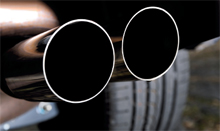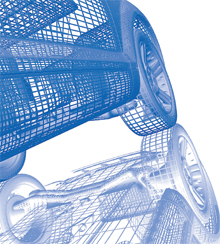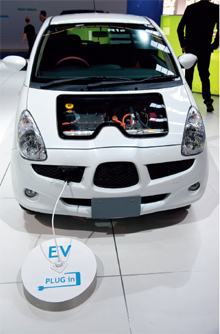Reduction of carbon dioxide emissions in the automobile industryTECHNICAL
Vicente Díaz, Susana Sanz. Automobile Security Institute. Carlos III University of Madrid
A very significant interdependency
exists between many climatic
phenomena that can be the cause of
natural disasters. Most of these
phenomena cannot be avoided but
what can be done is to mitigate the
catastrophes to which they give rise.
This article enumerates the main
measures that the automobile industry
currently applies to reduce as far as
possible CO2 emissions into the
atmosphere, thus minimising the
reduction in the ozone layer.
Introduction
The climate is mainly governed by short wave length radiation coming from the Sun, which is the only significant source of energy. This energy is partially captured by Earth’s surface and partly reflected outwards by the atmospheric components or the surface.
To establish energy balance the Earth must emit the same amount of energy as it absorbs from the Sun. Thus although the atmosphere is to a large degree transparent to -it does not absorbsolar radiation, nonetheless the radiation emitted into space by the Earth’s surface is long wave, which is indeed absorbed and emitted in turn by the atmospheric components.
This phenomenon, called the natural greenhouse effect, gives rise to heating of the atmosphere’s lower layers, commonly known as greenhouse effect gases. These are natural components of the atmosphere. This greenhouse effect is a natural phenomenon and thanks to it life on Earth as we know it today is possible.
Scientists recognise three processes as the main causes of changes in the energy balance that is established in the climatic system:
- Changes in the energy source -the Sun-.
- Variations in the Earth’s surface’s response (deforestation, changes in the use of land, changes in the extension of the snow cover).
- Alternatives in the atmosphere’s radiation characteristics.
Any one of these processes, by itself or jointly causes a change in the radiation balance.
The problem of detecting the changes arises because the climate’s natural variability is superimposed to it, which partially masks detection.
The Intergovernmental Panel on Climate Change (IPCC) confirms in its Assessment Report III that throughout the last century the average global temperature at the surface has increased, attributing this for the first time to human activities.
The changes in the climate derived from human activity are due to intensification of the natural greenhouse effect, when the atmospheric concentration of radioactively active gases increases and gives rise to what is known as radiative forcing.
If we focus on analysing CO2, the gas with most influence in the causes of climatic change, we find that one molecule of this gas –once emitted– remains in the atmosphere for an average term of four years before being captured by a reservoir, although the Earth overall needs more than a hundred years to adapt itself in the changes in its emissions and stabilise the atmospheric concentration again. Consequently if as of today one could achieve worldwide stabilisation of CO2 emissions, their atmospheric concentration would continue to increase throughout almost two centuries.
The international response to the challenge of climate change is materialised in two judicial instruments, the United Nations Framework Convention on Climate Change and the Kyoto Protocol, which develops and endows Convention’s generic prescriptions with concrete contents. The ultimate objective of the Protocol is to achieve stabilisation of the atmospheric concentration of greenhouse effect gases with the aim of preventing dangerous man made disturbances of the climatic system. The Kyoto Protocol -adopted in 1997- establishes for the first time, targets for reducing the net emissions of these gases for the developed countries or those with economies in a state of transition.
In the automobile industry the gas most monitored of those governed by the Kyoto Protocol is CO2. This is because internal combustion engines produce this gas.



Fundamental measures adopted by the automobile industry to reduce CO2
Ecological driving
In Spain the transport sector is the one with the highest consumption, totalling 42% of the final energy consumed in the country. Moreover this sector is responsible for more than 60 % of oil consumption and 30% of the total CO2. This explains the importance of adopting a cheap, ecological and safe driving style.
Over recent years the enormous progress in vehicle technology has not been accompanied by the corresponding evolution in the way of driving. Consequently as of today there is a major imbalance between both aspects.
In Spain the IDAE (Instituto para la Diversificación y el Ahorro de la Energía) (Institute for Energy Diversification and Saving) is currently implementing and promoting efficient driving techniques of private cars through two routes:
- In collaboration with the DGT (Dirección General de Tráfico) (General Directorate of Traffic) and driving schools associations.
- Training courses and programmes in collaboration with motoring clubs, hauliers associations, insurance companies and driving schools associations.
Efficient driving is a new driving style based on a series of new and simple techniques whose application (in injection vehicles) entails:
- Fuel savings in the region of 15%.
- Reduction of environmental contamination.
- Reduction of acoustic contamination.
- More comfortable travel.
- Savings in maintenance costs.
- Increased driving safety.
All this is achieved without increasing travelling time.
Sustainable vehicles
The current solutions for the environment in the field of mobility are materialised in three basic technologies that meet the need to reduce emissions into the atmosphere from terrestrial transport.
Hybrid vehicles
These vehicles incorporate two engines that
combine fossil fuel and electricity. These constitute
one of the innovations of transition
towards truly sustainable vehicles.
This is an ingenious proposal for people who
want all the performance of a high range
vehicle and to minimise consumption and
contamination.
Electric vehicles
In electric vehicles the fuel consists of electricity
stored in the form of chemical energy in
batteries. They do not release emissions and
have high performance, although their autonomy
is limited. For this reason their main
design is aimed at urban vehicles and the
majority of designs have reduced capacity.
Hydrogen vehicles
The essence of the hydrogen vehicle is the fuel
pile that extracts hydrogen’s electrons to convert
them into electricity. Currently the fuel
piles have achieved good levels of efficiency
and compactness, achieving modern driving
speeds.
Other technologies: compressed air vehicles
This type of vehicle, currently in a very advanced
stage of development functions with an engine
whose fuel is compressed air stored in tanks
that it carries.
The energetic power of compressed air is in
quadratic proportion to the pressure, and therefore
any increase in power and autonomy demands an aerodynamic design, minimum
weight and high performance on the road.
The driving force is obtained from the expansion
of compressed air fed into a closed chamber
(the cylinder) that drives the pistons that create
the motor’s stroke.
Alternative fuel engines
In addition to electric, hydrogen and compressed air combustion engines, others exist that allow alternative fuels such as ethanol, biodiesel or natural gas.
These cannot really be seen as noncontaminating vehicles with zero emissions, particularly those that work with biofuel made from vegetal materials, but we ought to consider them as sustainable vehicles. Some manufacturers have adapted models to allow them to work with ethanol and biodiesel. In Germany Elsbett modifies diesel engines so that they can work with any vegetal oil.
Vehicle weight reduction
As we all know the energy required for an automobile of mass “m” to reach a speed S (km/h) is:
E=0,5*m*S2
If we imagine that we do not want to dispense with travelling at a certain speed, the only way that exists of reducing energy requirement and thereby energy consumption is to make the mass “m” of the vehicle as small as possible.
Various manufacturing methodologies are applied to make vehicles’ bodywork ever lighter: new types of welding and ever thinner panels for example.
Another possibility is the use of ever lighter materials (essentially fibreglass, compounds).




Conclusions
To summarise, after a short introduction explaining why the climate is changing, this article has enumerated the various strategies that the automobile industry currently applies to resolve the problem of excessive carbon dioxide emissions. These are all aimed at solving it in the near future.
One can conclude that the automobile industry, for many years now, has been betting on ever cleaner technologies and is investing massive technological to alleviate the problem. We must not lose sight of the fact that we all form part of the automobile industry, because we are all, or at least the large majority of us, drivers, and thereby indirect CO2 contributors.


